AUDI A5 CABRIOLET 2017 Owners Manual
Manufacturer: AUDI, Model Year: 2017, Model line: A5 CABRIOLET, Model: AUDI A5 CABRIOLET 2017Pages: 266, PDF Size: 66.64 MB
Page 151 of 266
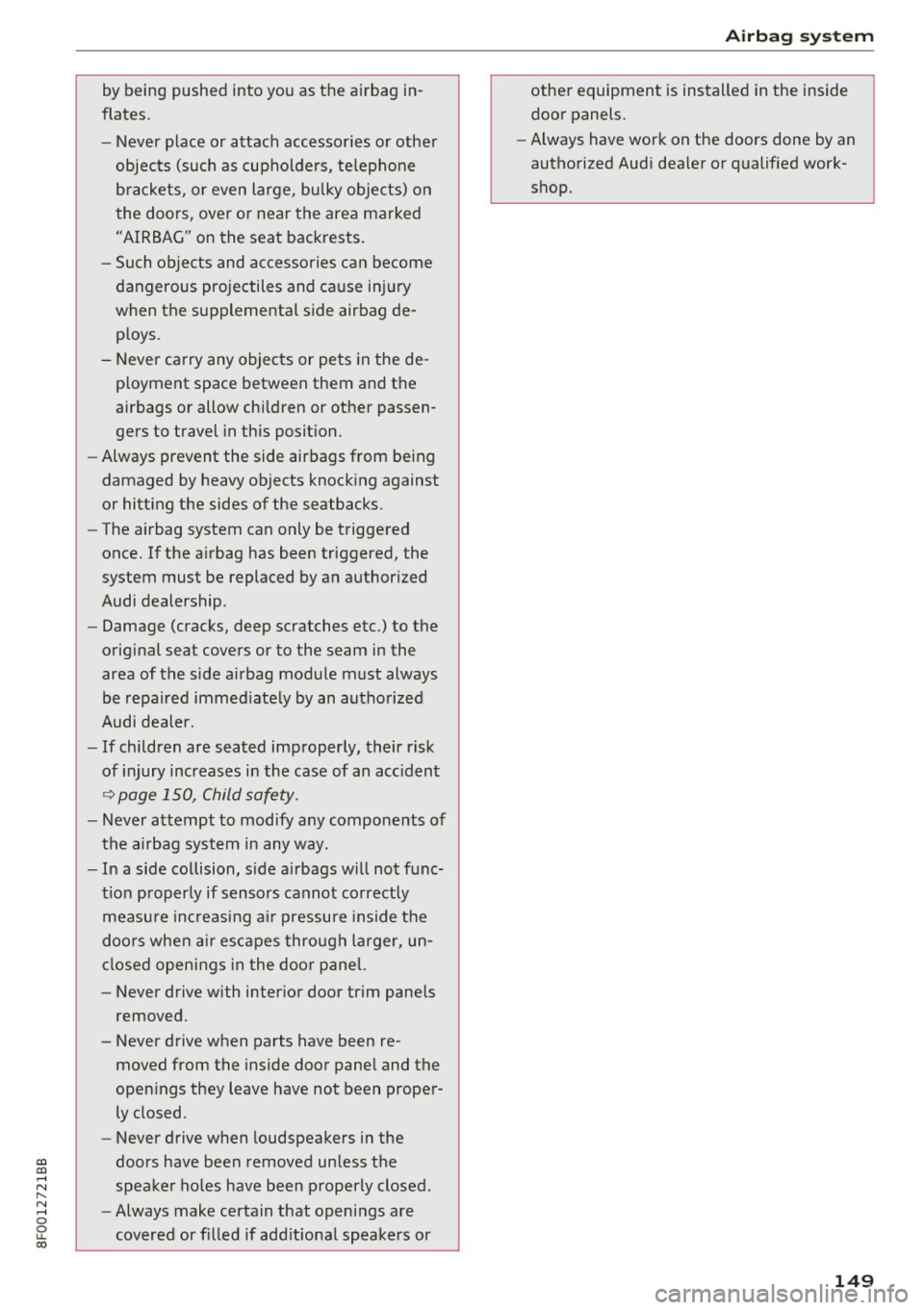
a:,
a:,
...... N r--. N ...... 0
0
LL 00
by being pushed into you as the airbag in
flates.
- Never place or attach accessories or other
objects (such as cupholders, telephone
brackets, or even large, bulky objects) on
the doors, over or near the area marked
"AIRBAG" on the seat backrests.
- Such objects and accessories can become
dangerous projectiles and cause injury
when the supplemental side airbag de
ploys.
- Never carry any objects or pets in the de ployment space between them and the
airbags or allow children or other passen
gers to travel in this position.
- Always prevent the side airbags from being
damaged by heavy objects knocking against
or hitting the sides of the seatbacks.
- The airbag system can only be triggered
once. If the airbag has been triggered, the
system must be replaced by an authorized
Audi dealership.
- Damage (cracks, deep scratches etc.) to the
original seat covers or to the seam in the
area of the side airbag module must always
be repaired immediately by an authorized
Audi dealer.
- If children are seated improperly, their risk
of injury increases in the case of an accident
~ page 150, Child safety.
-Never attempt to modify any components of
the airbag system in any way.
- In a side collision, side airbags will not func
tion properly if sensors cannot correctly
measure increasing air pressure inside the
doors when air escapes through larger, un
closed openings in the door panel.
- Never drive with interior door trim panels
removed.
- Never drive when parts have been re
moved from the inside door panel and the
openings they leave have not been proper
ly closed.
- Never drive when loudspeakers in the
doors have been removed unless the
speaker holes have been properly closed.
- Always make certain that openings are
covered or filled if additional speakers or
Airbag system
other equipment is installed in the inside
door panels.
- Always have work on the doors done by an
authorized Audi dealer or qualified work
shop.
149
Page 152 of 266
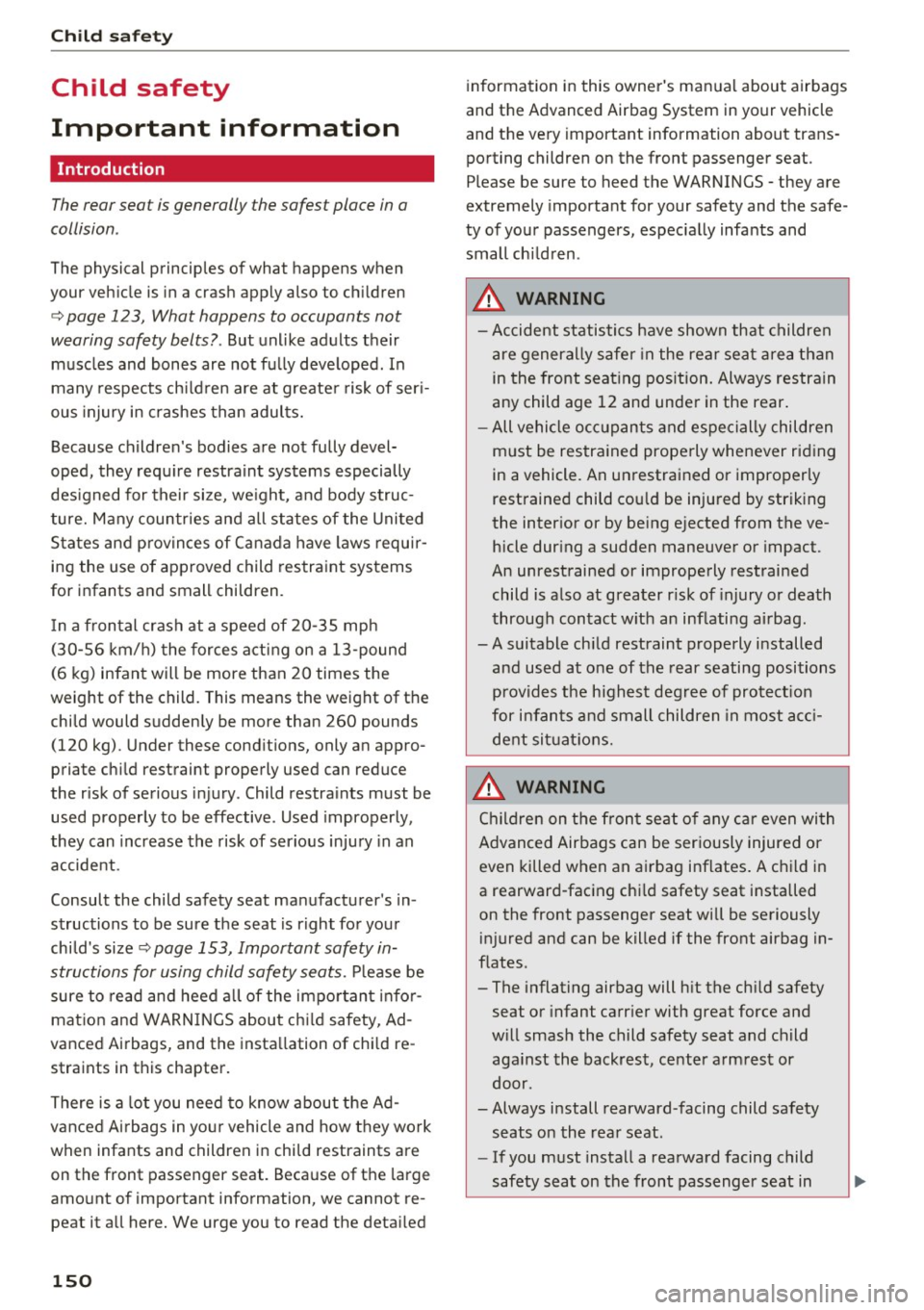
Child safety
Child safety
Important information
Introduction
The rear seat is generally the safest place in a
collision .
The physical principles of what happens when
your vehicle is in a crash apply also to children
¢ page 123, What happens to occupants not
wearing safety belts? .
But unlike adults their
muscles and bones are not fu lly deve loped . In
many respects ch ildren are at greater risk of ser i
ous injury in crashes than adults.
Because children's bodies are not fu lly devel
oped, they requ ire restraint systems especially
des igned for their size, we ight, and body struc
ture. Many countries and all states of the United
S tates and p rovinces of Canada have laws requir
ing the use of approved child restraint systems
for infants and small children.
I n a frontal crash at a speed of 20-35 mph
(30-56 km/h) the forces acting on a 13-pound
(6 kg) infant will be more than 20 times the
weight of the child. This means the weight of th e
child would suddenly be more than 260 pounds
(120 kg) . Under these conditions, only an appro
priate child restraint properly used can reduce
the risk of serious injury. Child restraints must be
used properly to be effective . Used improperly,
they can increase the risk of serious injury in an
accident.
Consult the child safety seat manufacturer's in
structions to be sure the seat is right for your
child's size¢
page 153, Important safety in
structions for using child safety seats.
Please be
sure to read and heed all of the important infor
mation and WARN INGS about ch ild safety, Ad
vanced Airbags, and the installation of child re
straints in this chapter.
There is a lot you need to know about the Ad
vanced Airbags in you r vehicle and how they work
when infants and children in child restraints are
on the front passenger seat . Because of the large
amount of important information, we cannot re
peat it all here. We urge you to read the detailed
150
information in this owner 's manual about airbags
and the Advanced Airbag System in your vehicle
and the very important information about trans
porting children on the front passenger seat.
Please be sure to heed the WARNINGS - they are
extremely important for your safety and the safe
ty of your passengers, especially infants and small chi ldren .
&_ WARNING
-Accident statistics have shown that children
are generally safer in the rear seat area than
in the front seating position. Always restrain
any child age 12 and under in the rear.
- All vehicle occupants and especially children
m ust be restrained properly whenever riding
in a vehicle. An unrestrained or improperly
restrained child cou ld be injured by striking
the interior or by being ejected from the ve hicle during a sudden maneuver or impact.
An unrestrained or improperly restrained
child is also at greater r isk of injury or death
through contact w ith an inflating airbag .
- A suitable ch ild restraint properly installed
and used at one of the rear seating positions
provides the highest degree of protect ion
for infants and small children in most acci
dent sit uat ions.
&_ WARNING
Children on the front seat of any car even with
Advanced Airbags can be ser iously injured or
even killed when an airbag inflates. A child in
a rearward-facing child safety seat installed
on the front passenger seat will be seriously
injured and can be killed if the front airbag in
flates.
- The inflating airbag will hit the ch ild safety
seat or infant carrier with great force and
w ill smash the child safety seat and child
aga inst the backrest, center armrest or
door.
-Always install rearward-facing child safety
seats on the rear seat.
- If you must install a rearward facing child
safety seat on the front passenger seat in
Page 153 of 266

a:,
a:,
...... N r--. N ...... 0
0
LL 00
exceptional circumstances and the PASSEN·
GER AIR BAG OFF
light does not come on
and stay on, immediately insta ll the rear
ward-facing child safety seat in a rear seat
ing posit ion and have the airbag system in
spected immediately by your authorized
Audi dealer.
A WARNING
If, in except ional circumstances, you must in
stall a forward-facing chi ld restraint on the
front passenger's seat :
- Always make sure the forward-fac ing seat
has been designed and certified by its man
ufacturer for use on a front seat with a pas
senger front and s ide airbag .
- Always follow the manufac turer 's instruc
tions provided with the chi ld safety seat or
carrier.
- Always move the passenger seat into its
rearmost position in the seat's fore and aft
adjustment range, as far away from the air
bag as possib le before installing the child
restra int. The backrest must be adjusted to
an upr ight position.
-Always make sure that the
PA SSENGER AIR
B AG OFF
light comes on and stays on all the
t ime whenever the ignition is switched on.
Always replace ch ild restraints that were in
stalled in a vehicle dur ing a crash. Damage to
a child restraint that is not visib le could cause
it to fail in another collision situation.
Advanced front airbag system and children
Your veh icle is equipped with a front "Advanced
A irbag System" i n compliance w ith United States
F edera l Moto r Vehicle Safety Standard ( FMVSS)
208, as well as Canada Motor Ve hicle Safety
Standard (CMVSS) 208 as applicable at the time
your vehicle was manufactured .
The Advanced Airbag system in your ve hicle has
been ce rtified to meet the " low-risk" requ ire
ments for 3 -and 6-yea r old children on the pas
senger side and sma ll adults on the driver side .
Child safety
The low risk deployment criteria a re intended to
reduce the risk of injury through interaction with
the a irbag that can occur, for example, by be ing
too close to the steering wheel and instrument panel when the airbag inflates. In addition, the
system has been certified to comply with the "suppression" requirements of the Safety Stand·
ard, to turn off the front airbag for infants up to
12 months who are restrained on the front pas
senger seat in ch ild rest raints that are listed in
the Standard.
Even though your veh icle is equipped with an Ad·
vanced Airbag system, all ch ild ren, especially
those 12 yea rs and you nger, sho uld a lways ride
in the back seat proper ly restrained for their age
and size . The airbag on the passenger side makes
the front seat a potentially dangerous p lace for a
child to ride. The front seat is not the safest place
for a ch ild in a forward-fac ing ch ild safety seat. It
can be a very dangerous place for an infant or a
larger ch ild in a rearward-facing seat .
' Advanced Airbags and the weight-sensing
mat in the front seat
The Advanced A irbag System in your vehicle de
tects the presence of an infant or chi ld in a chi ld
restraint on the front passenger seat using the
weight -sensing mat in the seat cushion and the
sensor below the safety belt latch on the front
passenger seat that measures the tens ion on the
safety belt.
The weight-sensing mat measures total weight of the child and the chi ld safety seat and a child
blanket on the front passenger seat . The weight
on the front passenger seat is related to the de
s ign of the child restra int and its "footprint", the
s ize and shape of the bottom of the ch ild re-
straint as it sits on the seat. The weight of a ch ild
restra int and its "footprint" va ry for different
k inds of child restra ints and for the different
models of the same kind o f chi ld rest raint of -
fered by chi ld restraint manufacturers.
T he we igh t ranges for the indiv id ual types,
makes and mode ls of ch ild restraints that the
NH TSA has specified in the Safety Standard to
gether with the weight ranges of typical infants .,.
15 1
Page 154 of 266
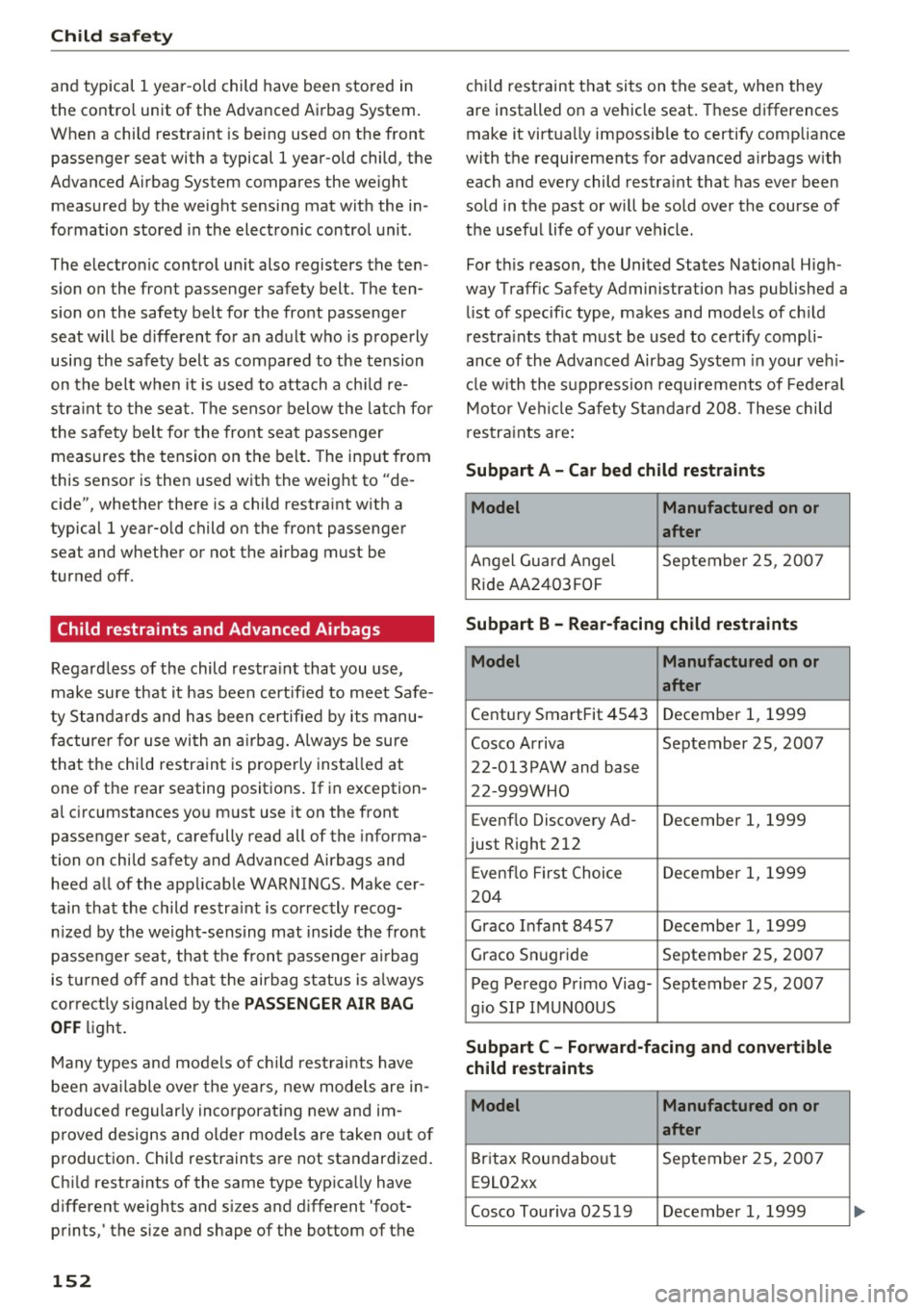
Child safet y
and typical 1 year -old child have been sto red in
the co ntrol unit of the Advanced Airbag System.
When a chi ld restra int is being used on the front
passenger seat with a typical 1 year-old child, the
Advanced Airbag System compares the we ight
measured by the we ight sensing mat with the in
formation stored in the electronic control unit.
The electronic control un it also registers the ten
sion on the front passenger safety belt. The ten
sion on the safety belt for the fro nt passenger
seat will be d ifferent for an adult w ho is p roperly
using the safety belt as compared to the tension
on the belt w hen it is used to attach a ch ild re
s tra int to the sea t. The senso r below the la tch for
t he safety belt for the front sea t passenger
measures the tension on the belt. The inp ut from
this senso r is then used with the weight to "de
cide", whether there is a child restra int w ith a
typical 1 year-old child on the front passenge r
seat and whether or not the a irbag must be
turned off.
Child restraints and Advanced Airbags
Regard less of the child restra int tha t you use,
make su re that it h as been cert ified to meet Safe
ty Standa rds and has been certified by its manu
facture r for use wi th an a irba g. A lways be sure
t hat the chi ld restrain t is properly insta lled at
one of the rear seating positions . If in exception
al c ircumstances yo u m ust use it on the front
passenger seat, carefully read all of the informa
tion on child safety and Advanced Airbags and heed a ll of the app licab le WARNINGS . Make cer
tain tha t the child res tra int is correc tly recog
n iz ed by the we ight-sens ing mat inside the front
passenger seat, that t he fron t passe nger a irbag
is t urned off and tha t the airbag st atus is always
corre ct ly sign aled by the
PASSENGER AIR BAG
OFF li ght .
M any types and mo dels of child res traints have
been available ove r the ye ars, new mode ls are in
troduce d regularly inco rpora ting new and im
p roved designs and o lder mode ls are taken o ut of
product ion . Chi ld restraints a re not standardized .
Ch ild restraints of the same type typ ica lly have
d ifferent weights and s izes and d ifferent 'foot
prints,' the size a nd shape of the bottom of t he
152 ch
ild restraint t hat sits on the seat, when they
a re installed on a vehicle seat . These differences
make it virtua lly impossib le to certify comp liance
with the requirements for advanced a irbags w ith
each and every child restra int that has ever been
sold in the past or wi ll be sold over the course of
t h e usefu l life of your vehicle .
For t his reason, the United States National High
way Traffic Safety Admin istrat ion has published a
li st of specific type, makes and mode ls of ch ild
res tra ints tha t must be used to certify compli
ance of the Advanced Airbag System in your ve hi
cl e w ith the s uppression requirements of Federa l
Mot or Ve hicl e Safety St and a rd 208. These child
r es tra ints are :
Subpart A- Car bed child restraints
Model Manufactured on or
after
A ngel Guard Angel Se pte mber 2 5, 20 07
Ride AA 2403F OF
Subpart B - Rear-facing child restraints
Model Manufactured on or
after
Century SmartFit 4543 December 1, 1999
Cosco Arriva September 25, 2007
22-013PAW and base 22- 999WHO
Evenflo Discove ry Ad- December 1, 1999
just R ight 212
E ven flo Firs t Choi ce December
1, 1 999
2 04
Grace I nfant 8457 December 1, 1999
Grace Sn ugride September 25, 2007
Peg Perego Primo Viag- September 25, 2007
g io SIP I MUNOOUS
Subpart C -Forward-facing and convertible
child restraints
Model Manufactured on or
after
Br itax Roundabo ut September 25, 2007
E9L02xx
Cosco Tou riva 0 2519 December 1, 1999
...
Page 155 of 266
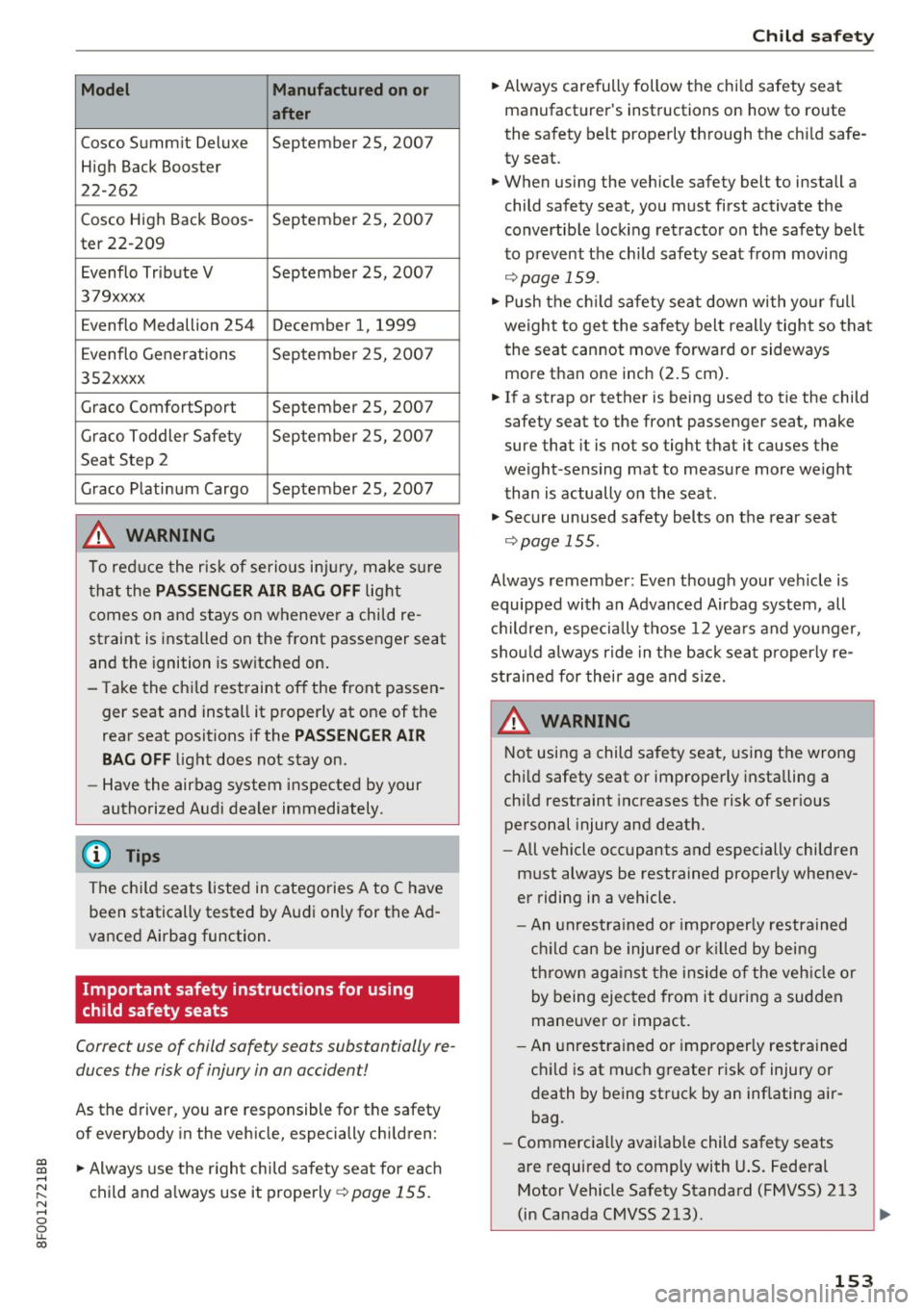
Model Manufactured on or
after
Cosco Summit Deluxe September 25, 2007
High Back Booster
22-262
Cosco High Back Boos -
September 25, 200 7
ter 22-209
Evenflo Tr ibute V September 25, 2007
379xxxx
Evenflo Medallion 254 December 1, 1999
Evenflo Generations September 25, 2007
352xxxx
Graco ComfortSport September 25, 2007
Graco Toddler Safety September 25, 2007
Seat Step 2
Graco Platinum Cargo September 25, 2007
.&, WARNING
To reduce the risk of serious inju ry, make sure
that the
PA SSEN GER AIR BAG OFF light
comes on and stays on whenever a child re
straint is installed on the front passenger seat
and the ignition is switched on.
- Take the child restraint off the front passen
ger seat and install it properly at one of the
rear seat positions if the
P A SSEN GER AIR
BAG OFF
light does not stay on.
- Have the airbag system inspected by your
authorized Audi dealer immediately.
(D Tips
The chi ld seats listed in categories A to C have
been statically tested by Audi only for the Ad
vanced Airbag function.
Important safety instructions for using
child safety seats
Correct use of child safety seats substantially re
duces the risk of injury in an accident!
As the driver, you are responsible for the safety
of everybody in the veh icle, especially children:
gi .,. Always use the right chi ld safety seat for each ......
~ child and a lways use it properly qpage 155. N ...... 0
0
LL 00
Child safety
.,. Always carefully follow the chi ld safety seat
manufacturer's instructions on how to route
the safety belt properly through the ch ild safe
ty seat.
.,. When using the vehicle safety belt to install a
child safety seat, you must first activate the
convertible locking retractor on the safety belt
to prevent the chi ld safety seat from moving
q page 159.
.,. Push the ch ild safety sea t down with yo ur full
weight to get the safety belt really tight so that the seat cannot move forward or sideways
more than one inch (2.5 cm).
.,. If a strap or tether is being used to tie the child
safety seat to the front passenger seat, make
sure that it is not so tight that it causes the
weight -sensing mat to measure more weight
than is actually on the seat .
.,. Secure unused safety belts on the rear seat
q page 155.
Always remember: Even though your veh icle is
equipped with an Advanced Airbag system, all
c hi ldren, especia lly t hose 12 yea rs and younger,
sho uld a lways ride in th e back seat p roper ly re·
strained for their age and s ize.
A WARNING
=
Not using a child safety seat, using the wrong
chi ld safety seat or improperly insta lling a
chi ld restraint increases the risk of serious
personal injury and death.
- All vehicle occupants and especially children
must always be restrained properly whenev
er riding in a vehicle.
- An unrestra ined o r improperly restrained
c hi ld can be injured o r killed by being
thrown aga inst the inside of the veh icle or
by being ejected from it during a sudden
maneuver or impact.
- An unrestra ined or improperly restrained
child is at much greater risk of injury or
death by being struck by an inflating air bag.
- Commercially availab le child safety seats
are requi red to comply with U .S. Federal
Motor Vehicle Safety Standard (FMVSS) 213
(in Canada CMVSS 213). ..,_
153
Page 156 of 266
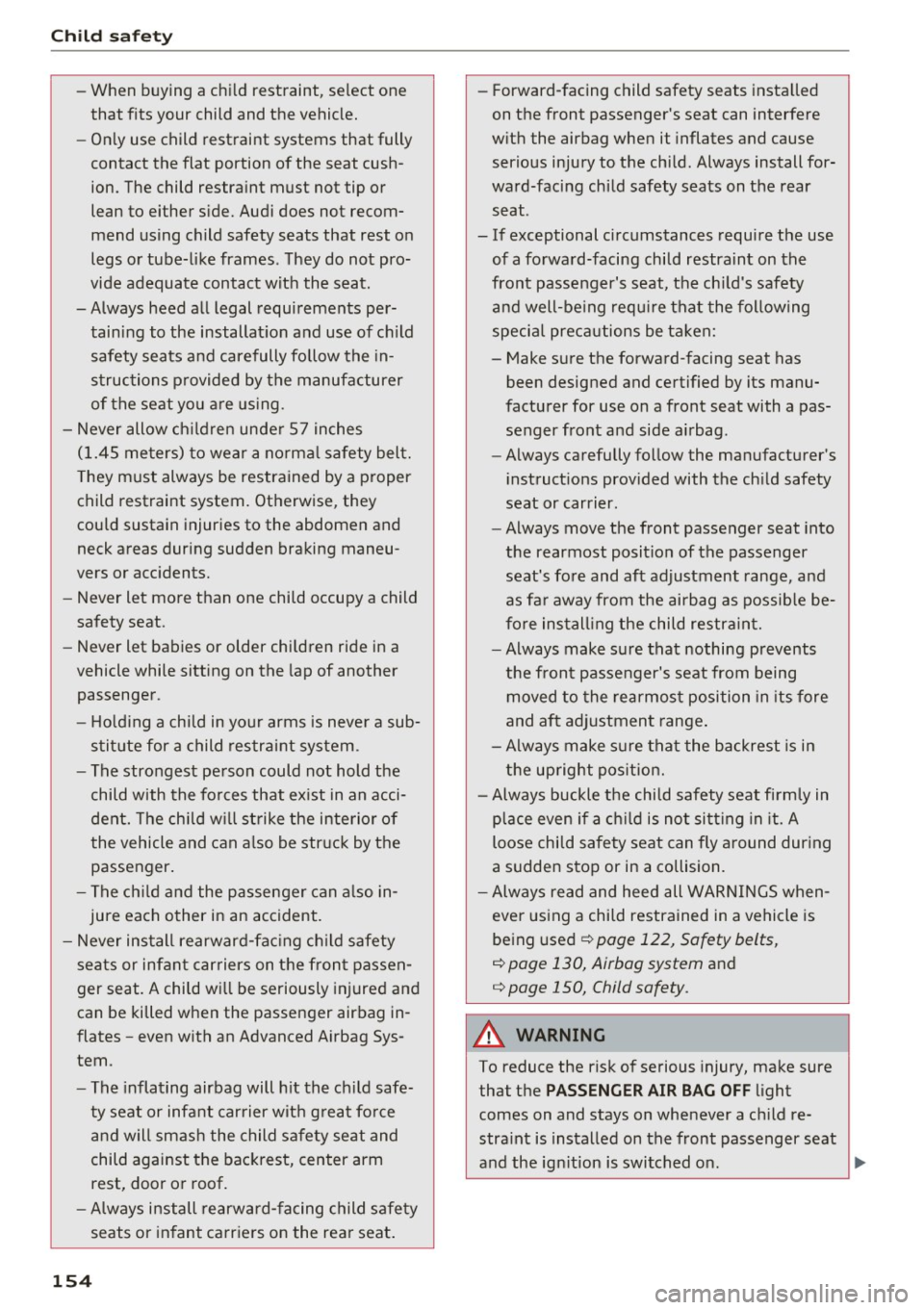
Child safety
-When buying a child restraint, select one
that fits your child and the vehicle.
- Only use child restraint systems that fully
contact the flat portion of the seat cush
ion. The child restraint must not tip or
lean to either side. Audi does not recom
mend using child safety seats that rest on
legs or tube-like frames . They do not pro
vide adequate contact with the seat.
- Always heed all legal requirements per
taining to the installation and use of child
safety seats and carefully follow the in
structions provided by the manufacturer
of the seat you are using.
- Never allow children under 57 inches
(1.45 meters) to wear a normal safety belt.
They must always be restrained by a proper
child restraint system. Otherwise, they
could sustain injuries to the abdomen and
neck areas during sudden braking maneu
vers or accidents.
- Never let more than one child occupy a child
safety seat.
- Never let babies or older children ride in a
vehicle while sitting on the lap of another
passenger .
- Holding a child in your arms is never a sub
stitute for a child restraint system.
- The strongest person could not hold the
child with the forces that exist in an acci
dent. The child will strike the interior of
the vehicle and can also be struck by the
passenger.
- The child and the passenger can also in
jure each other in an accident.
- Never install rearward-facing child safety
seats or infant carriers on the front passen
ger seat. A child will be seriously injured and
can be killed when the passenger airbag in
flates -even with an Advanced Airbag Sys
tem .
- The inflating airbag will hit the child safe
ty seat or infant carrier with great force
and will smash the child safety seat and
child against the backrest, center arm
rest, door or roof.
- Always install rearward-facing child safety
seats or infant carriers on the rear seat.
154
-Forward-facing child safety seats installed
on the front passenger's seat can interfere
with the airbag when it inflates and cause
serious injury to the child . Always install for
ward-facing child safety seats on the rear seat .
- If exceptional circumstances require the use
of a forward-facing child restraint on the
front passenger's seat, the child's safety
and well-being require that the following
special precautions be taken:
- Make sure the forward-facing seat has been designed and certified by its manu
facturer for use on a front seat with a pas
senger front and side airbag .
- Always carefully follow the manufacturer's
instructions provided with the child safety
seat or carrier.
- Always move the front passenger seat into
the rearmost position of the passenger
seat's fore and aft adjustment range, and
as far away from the airbag as possible be
fore installing the child restraint.
- Always make sure that nothing prevents
the front passenger's seat from being
moved to the rearmost position in its fore
and aft adjustment range.
- Always make sure that the backrest is in
the upright position.
- Always buckle the child safety seat firmly in
place even if a child is not sitting in it. A
loose child safety seat can fly around during
a sudden stop or in a collision.
- Always read and heed all WARNINGS when
ever using a child restrained in a vehicle is
being used¢
page 122, Safety belts,
¢ page 130, Airbag system
and
¢ page 150, Child safety.
A WARNING
To reduce the risk of serious injury, make sure
that the
PASSENGER AIR BAG OFF light
comes on and stays on whenever a child re
straint is installed on the front passenger seat
and the ignition is switched on. ..,.
Page 157 of 266
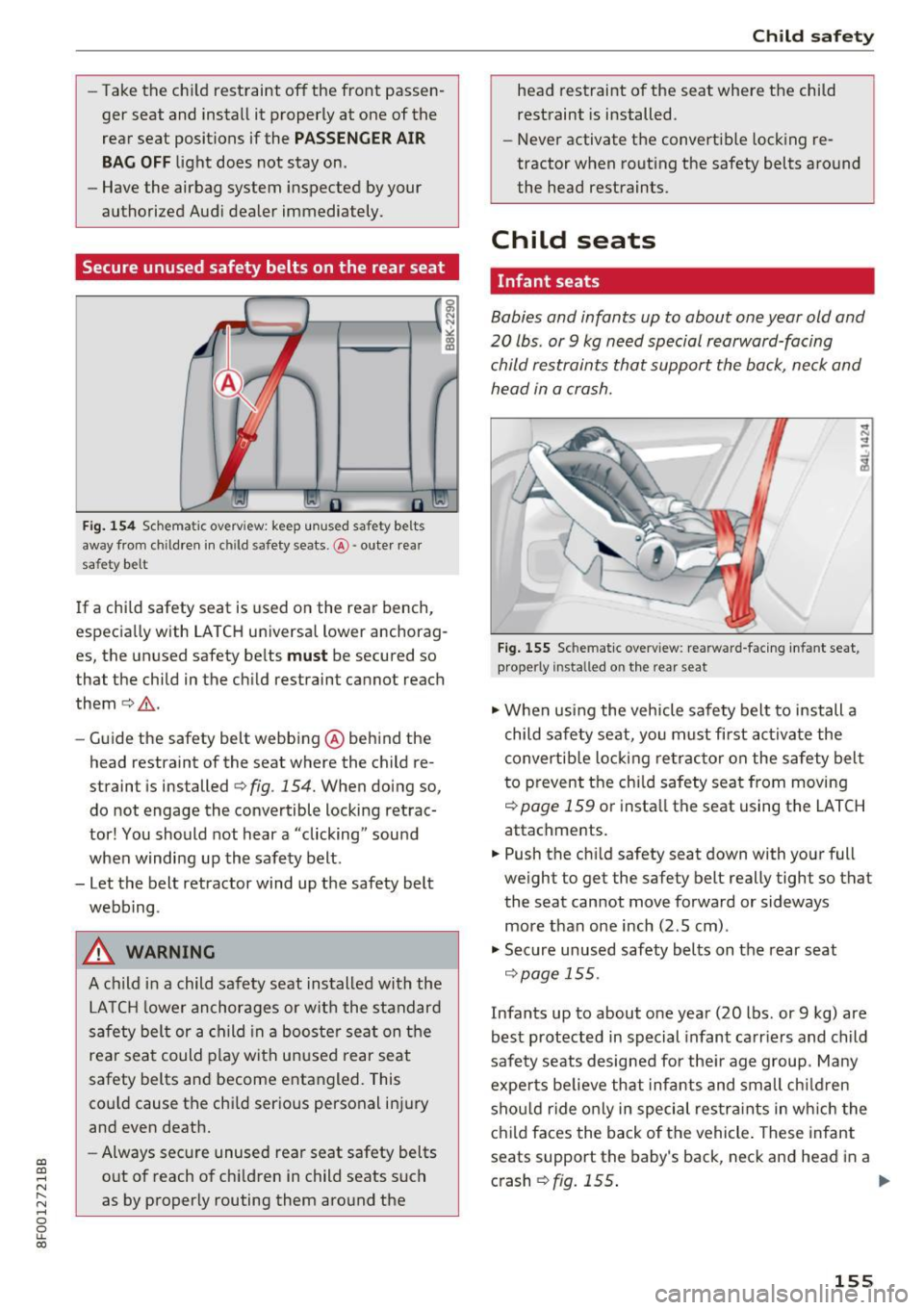
a:,
a:,
...... N
" N ...... 0
0
LL co
-Take the child restraint off the front passen
ger seat and install it properly at one of the
rear seat positions if the
PASSENGER AIR
BAG OFF
light does not stay on.
- Have the airbag system inspected by your
authorized Audi dealer immediately.
Secure unused safety belts on the rear seat
Fig. 154 Schemat ic overv iew: keep unused s-afety belts
away from children in chil d safety seats. @-oute r rear
sa fety belt
If a chi ld safety seat is used on the rear bench,
especially with LA TCH universal lower anchorag
es, the unused safety belts
must be secured so
that the child in the child restraint cannot reach
them
c::> ,& .
-Guide the safety belt webbing @behind the
head restraint of the seat where the child re
straint is installed
c::> fig . 154. When doing so,
do not engage the convertible locking retrac
tor! You should not hear a "clicking" sound
when winding up the safety belt .
- Let the belt retractor wind up the safety belt
webbing .
A WARNING
A child in a child safety seat installed with the
LATCH lower anchorages or with the standard
safety belt or a child in a booste r seat on the
rear seat could play with unused rear seat
safety belts and become entangled. This
cou ld cause the chi ld serious personal injury
and even death.
- Always secure unused rear seat safety belts
out of reach of children in child seats such
as by proper ly routing them aro und the
Child safety
head restraint of the seat where the child
restraint is installed .
- Never activate the convertible locking re
tractor when routing the safety belts around
the head restraints.
Child seats
Infant seats
Babies and infants up to about one year old and
20 lbs. or
9 kg need special rearward-facing
child restraints that support the back , neck and
head in a crash.
Fig. 155 Schematic overview: rearward -facing infant seat,
p roper ly insta lled o n the rear seat
... When using the vehicle safety belt to install a
child safety seat, you must first activate the
convertib le locking retractor on the safety belt
to prevent the child safety seat from moving
c::>poge 159 or install the seat using the LATCH
attachments.
... Push the ch ild safety seat down with your full
weight to get the safety belt really tight so that
the seat cannot move forward or sideways more than one inch (2 .5 cm) .
... Secure unused safety belts on the rear seat
c::>page 155.
Infants up to about one year (20 lbs. or 9 kg) are
best protected in special infant carriers and child
safety seats designed for their age group . Many
experts believe that infants and small children
shou ld ride only in special restraints in which the
child faces the back of the vehicle. These infant
seats support the baby's back, neck and head in a
crash
r=;, fig. 155 . .,..
155
Page 158 of 266
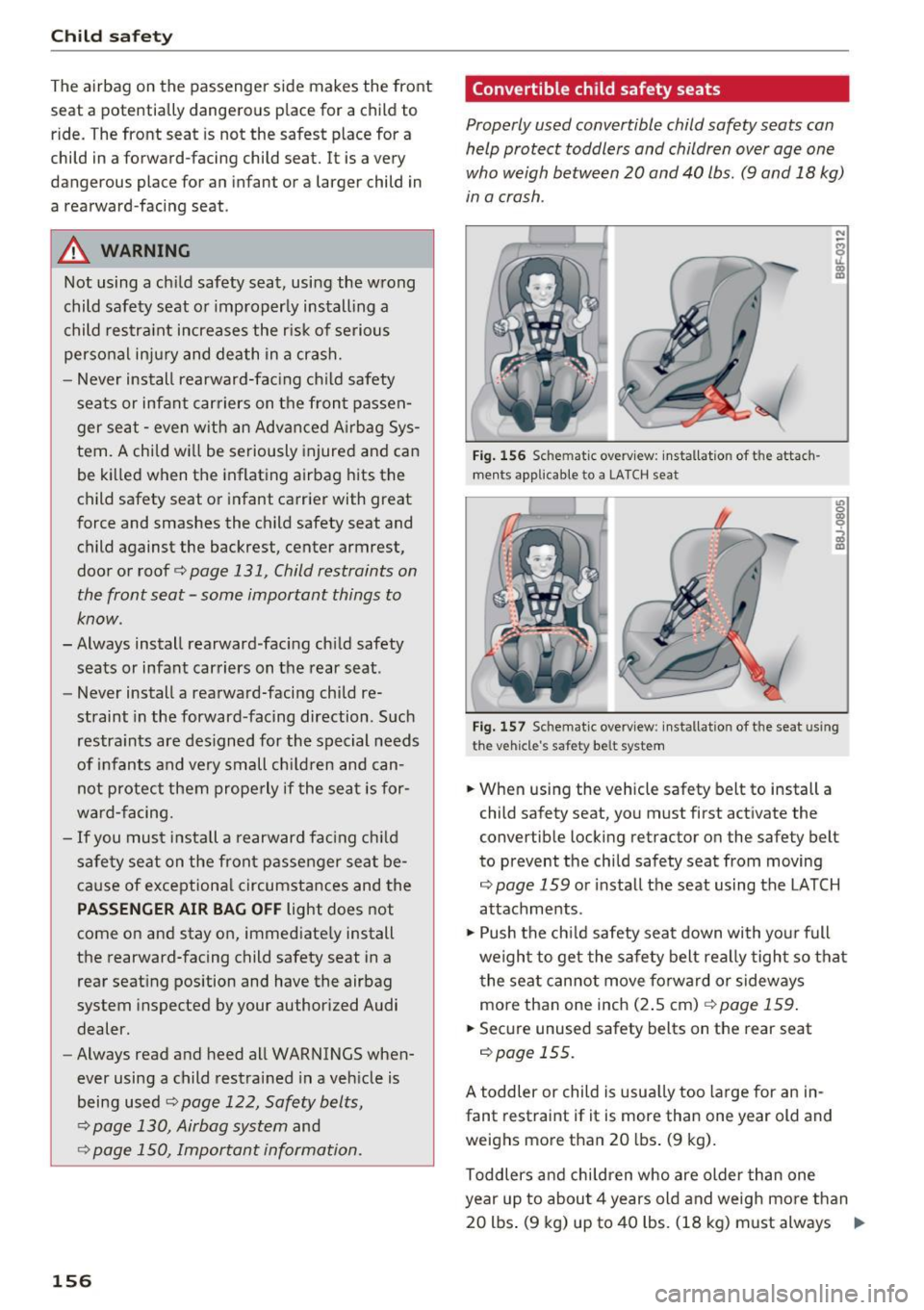
Child safety
The airbag on the passenger side makes the front
seat a potentially dangerous p lace for a child to
ride. The front seat is not the safest place for a
child in a forward-facing child seat. It is a very
dangerous place for an infant or a larger child in
a rearward-fac ing seat.
A WARNING
Not using a ch ild safety seat, using the wrong
child safety seat or improperly installing a
child restra int increases the r isk of serious
personal inju ry and death in a crash.
- Never install rearward-fac ing ch ild safety
seats or infant carriers on the front passen ger seat -even w ith an Advanced A irbag Sys
tem. A child will be seriously injured and can
be ki lled when the inflating airbag hits the
child safety seat or infant carrier with great
force and smashes the child safety seat and
child against the backrest, center armrest,
door or roof
c::, page 131, Child restraints on
the front seat -some important things to
know.
-Always install rearward-fac ing ch ild safety
seats or infant carriers on the rear seat.
- Never install a rearward-facing child re
straint in the forward-facing direction. Such restra ints are des igned for the special needs
of infants and very small ch ild ren and can
not protect them properly if the seat is for
ward- facing.
- If you mus t install a rearward fac ing ch ild
safe ty seat on the front passenger seat be
ca use of exceptiona l circumstances and the
PASSENGER AIR BAG OFF light does not
come on and stay on, immediate ly install
the rearward-facing child safety seat in a
rear seat ing position and have the airbag
system inspected by your author ized Audi
dealer.
- Always read and heed all WARNINGS when
ever using a child restrained in a veh icle is
being used
c:> page 122, Safety belts,
c:> page 130, Airbag system and
9 page 150, Important information.
156
Convertible child safety seats
Properly used convertible child safety seats can
help protect toddlers and children over age one
who weigh between 20 and 40 lbs. (9 and 18 kg)
in a crash.
Fig . 156 Schemat ic overv iew : installat ion of the attach
ments applicable to a LA TCH seat
Fig. 157 Schemat ic overv iew: installat ion of the seat using
the vehicle's safety belt system
.. When using the vehicle safety belt to install a
child safety seat, you must first activate the
convertib le locking retractor on the safety belt
to prevent the child safety seat from moving
c:> page 159 or install the seat using the LATCH
attachments .
.. Push the chi ld safety seat down wi th your full
we igh t to get the safe ty belt really tight so that
the seat cannot move forward or sideways
more than one inch (2 .5 cm)
c:>page 159.
.. Secure unused safety belts on the rear seat
c:> page 155.
A toddler or child is usua lly too la rge for an in
fant restraint if it is more than one year old and
weighs more than 20 lbs . (9 kg).
Toddlers a nd chi ldren who are older than one
year up to about 4 years old and weigh more than 20 lbs . (9 kg) up to 40 lbs. (18 kg) must always ..,.
Page 159 of 266
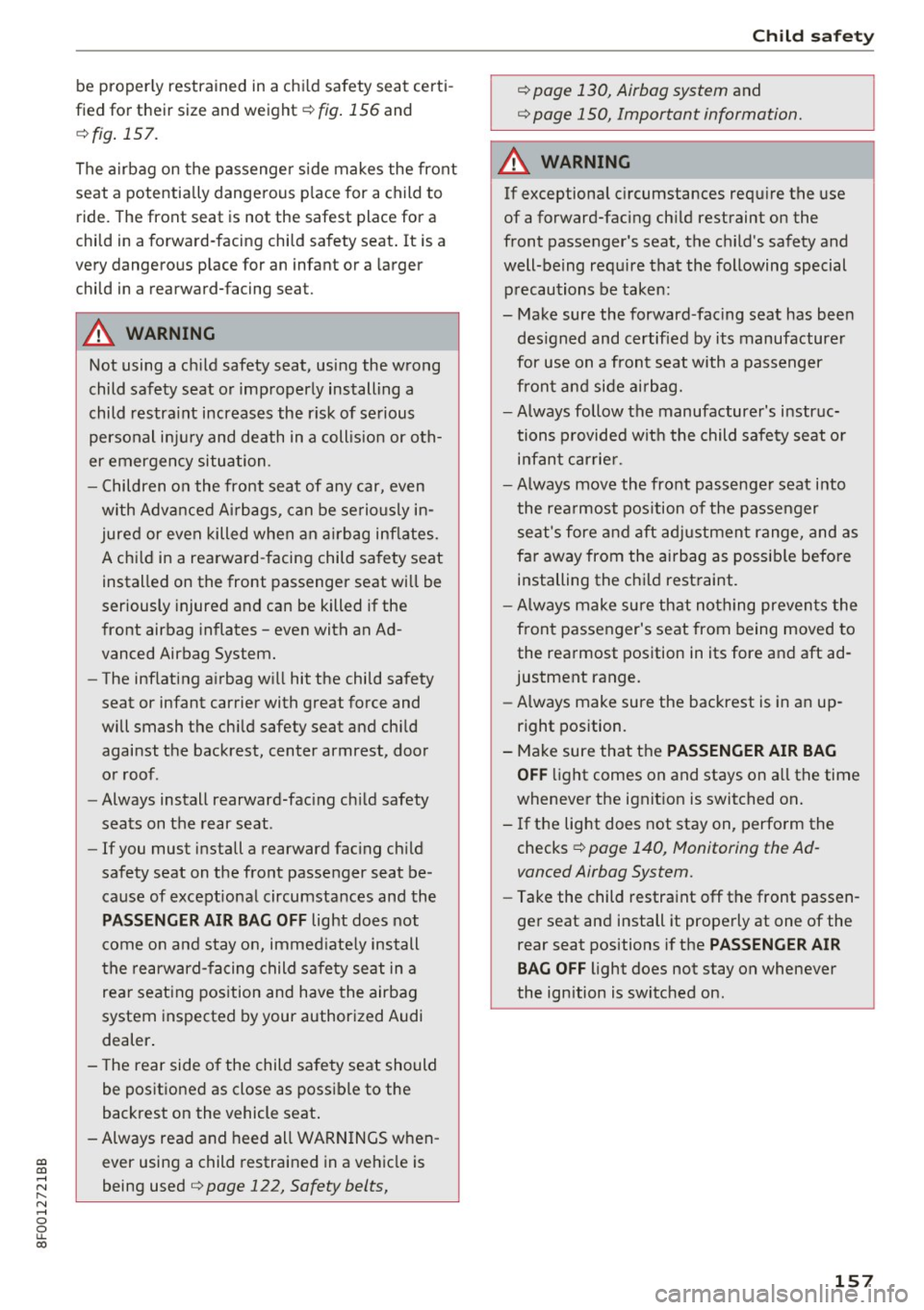
a:,
a:,
...... N r--. N ...... 0
0
LL 00
be properly restrained in a chi ld safety seat certi
fied for their size and weight¢
fig. 156 and
¢fig . 157.
The airbag on the passenger side makes the front
seat a potentia lly dangerous p lace for a child to
ride. The front seat is not the safest place for a
child in a forward-facing child safety seat . It is a
very dangerous place for an infant or a larger
child in a rearward-facing seat.
A WARNING
Not using a ch ild safety seat, using the wrong
child safety seat or improperly installing a
child restra int increases the r isk of serious
personal inju ry and death in a collis ion or oth
er emergency situation.
- Children on the front seat of any car, even
with Advanced Airbags, can be seriously in
jured or even killed when an a irbag inflates.
A chi ld in a rearward-facing child safety seat
installed on the front passenger seat wi ll be
seriously injured and can be killed if the
front airbag inflates -even with an Ad
vanced Airbag System.
- The inflating a irbag w ill hit the child safety
seat or infant carrier with great force and
will smash the child safety seat and child
against the backrest, center armrest, door
or roof .
- Always install rearward-fac ing ch ild safety
seats on the rear seat .
- If you must install a rearward fac ing ch ild
safety seat on the front passenger seat be cause of exceptional circumstances and the
PASSENGER AIR BAG OFF light does not
come on and stay on, immed iate ly install
the rearward-facing child safety seat in a
rear seating position and have the airbag
system inspected by your authorized Audi
dealer .
- The rear side of the child safety seat should
be positioned as close as possible to the
backrest on the vehicle seat .
-Always read and heed all WARNINGS when
ever using a child restrained in a vehicle is
being used ¢
page 122, Safety belts,
Child safety
¢ page 130 , Airbag system and
¢ page 150, Important information.
A WARNING
-If exceptional c ircumstances requ ire the use
of a forward-facing ch ild restraint on the
front passenger's seat, the child's safety and well-being requ ire that the following special
p recautions be taken:
- Make sure the forward-fac ing seat has been
designed and certified by its manufacturer
for use on a front seat with a passenger
front and side ai rbag.
- Always follow the manufacturer's instruc
tions provided with the child safety seat o r
infant carrie r.
- Always move the front passenger seat into
the rea rmost pos ition of the passenger
seat's fore and aft adjustment range, and as
far away from the airbag as possib le before
installing the child restraint.
- Always make sure that nothing preven ts the
front passenger's seat from being moved to
the rearmost position in its fore and aft ad ·
justment range.
- Always make sure the backrest is in an up
right position.
- Make sure that the
PASSENGER AIR BAG
OFF
li ght comes on and stays on all the time
whenever the ignit ion is switched on .
- If the light does not stay on, perform the
checks ¢
page 140, Monitoring the Ad
vanced Airbag System.
- Take the child restraint off the front passen
ge r seat and install it properly at one of the
rear seat positions if the
PA SS ENGER AIR
BAG OFF
light does not stay on whenever
the ignition is switched on.
157
Page 160 of 266
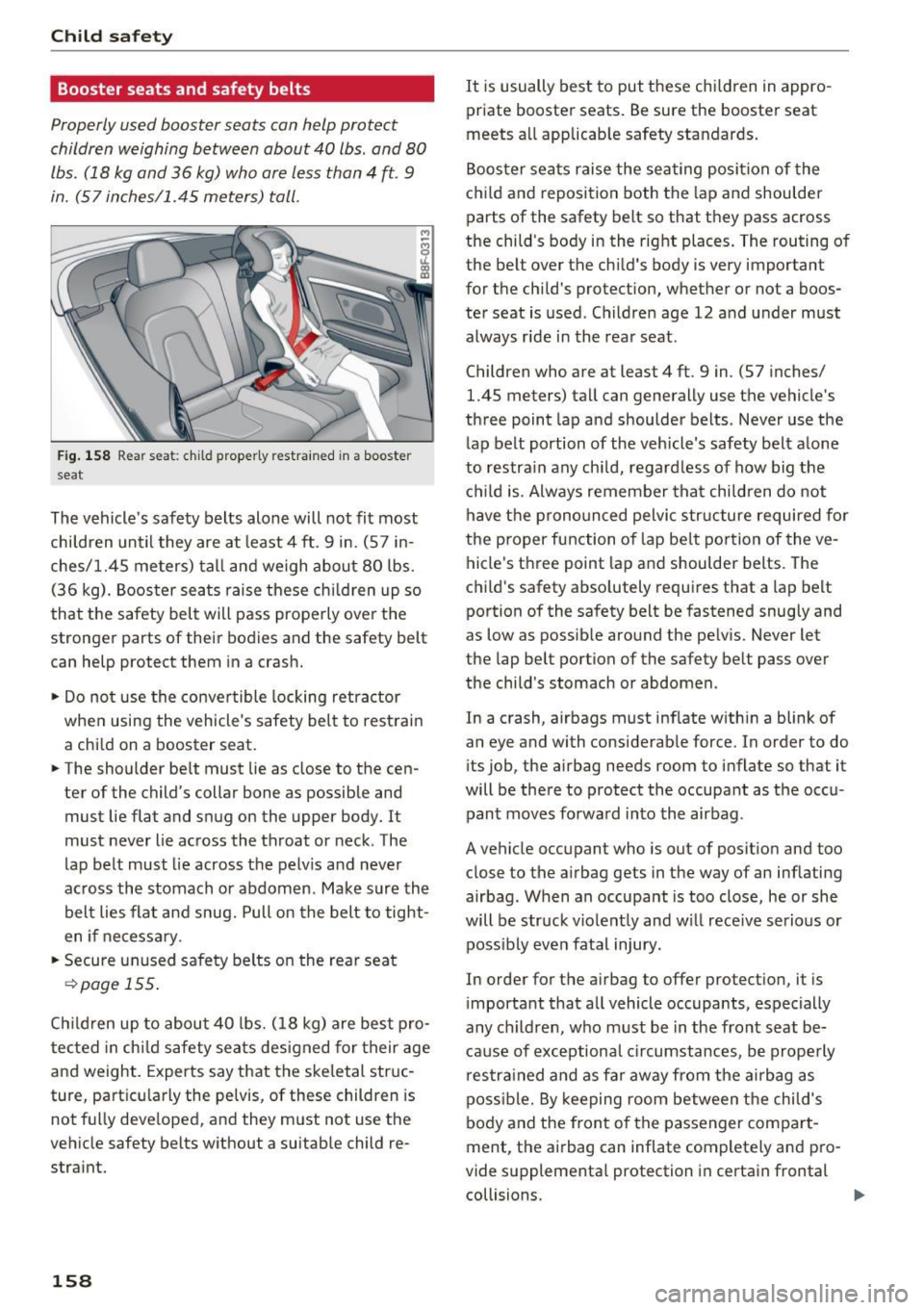
Child safety
Booster seats and safety belts
Properly used booster seats can help protect
children weighing between about 40 lbs . and 80
lbs. (18 kg and 36 kg) who are less than 4
ft. 9
in. (57 inches/1.45 meters) tall .
Fig. 158 Rear seat: ch ild proper ly restrained in a booster
seat
The vehicle's safety belts alone will not fit most
children until they are at least 4 ft. 9 in. (57 in
ches/1.45 meters) tall and weigh about 80 lbs .
(36 kg). Booster seats raise these chi ld ren up so
that the safety belt will pass properly
over the
stronger parts of their bodies and the safety belt
can help protect them in a crash.
• Do not use the convertible locking retractor
when using the vehicle's safety belt to restrain
a chi ld on a booster seat.
• The shoulder be lt must lie as close to the cen
ter of the child's collar bone as possible and
must lie flat and snug on the upper body. It
must
never lie across the throat or neck. The
lap belt must lie across the pelv is and
never
across the stomach or abdomen . Make sure the
belt lies flat and snug. Pull on the belt to tight
en if necessary .
• Secure unused safety belts on the rear seat
¢page 155.
Child ren up to about 40 lbs. (18 kg) are best pro
tected in chi ld safety seats des igned for their age
and weight . Experts say that the skeletal str uc
ture, part icu larly the pelvis, of these children is
not fully deve loped , and they must not use the
vehicle safety belts without a suitable child re
stra int.
158
It is usually best to put these children in appro
priate booster seats. Be sure the booster seat
meets all applicab le safety standards .
Booster seats raise the seating posi tion of the
child and reposition both the lap and shoulder
parts of the safety belt so that they pass across
the child 's body in the right places. The routing of
the belt over the ch ild's body is
very important
for the child's protection, whether or not a boos
ter seat is used. Child ren age 12 and under must
always ride in the rear seat.
Children who are at least 4 ft. 9 in . (57 inches/
1.45 meters) tall can generally use the vehicle's
three point lap and shoulder belts. Never use the
l ap belt portion of the veh icle's safety belt a lone
to restrain any child, regard less of how big the
child is. Always remember that children do not
have the pronounced pelvic structure required for
the proper function of lap belt portion of the ve
hicle's three point lap and shoulder belts. The
child's safety abso lutely requires that a lap belt
portion of the safety belt be fastened snugly and
as low as possible around the pe lvis. Never let
the lap belt portion of the safety belt pass over
the child 's stomach or abdomen .
In a crash, airbags must inflate with in a blink of
an eye and with considerab le force. In order to do
its job, the a irbag needs room to inflate so that it
will be there to protect the occupant as the occu
pant moves forward into the airbag.
A vehicle occupant who is out of position and too
close to the airbag gets in the way of an inf lating
airbag . When an occupant is too close, he or she
will be struck vio lent ly and w ill rece ive serio us or
possibly even fatal injury.
In order for the a irbag to offer protection, it is
important that all vehicle occupants, especially
any ch ildren, w ho must be in the front seat be
cause of exceptional circumstances, be properly
restrained and as far away from the airbag as
possible. By keeping room between the child's
body and the front of the passenger compart
ment, the airbag can inflate completely and pro
vide supplementa l protection in certain frontal
collisions.